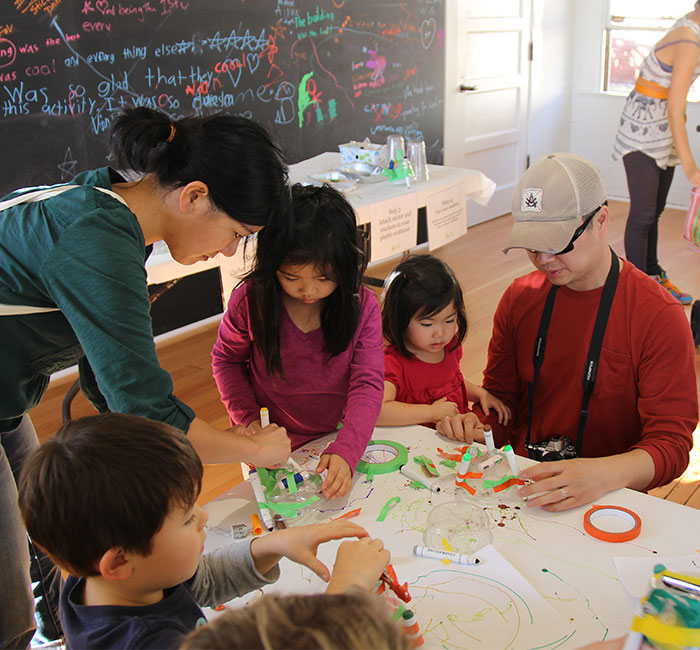The STEM Starts Early report talks about learning trajectories in early STEM. What are they? What difference do they make?
What Are Learning Trajectories?
Children follow natural developmental progressions in learning and development. As a simple example, they learn to crawl, then walk, then run, skip, and jump with increasing speed and dexterity. These are the levels in the development of movement. They follow natural developmental progressions in learning STEM content, too, learning ideas and skills in their own way. When teachers understand these developmental progressions for each major topic, and sequence activities based on them, they build learning environments that are particularly developmentally appropriate and effective.
Developmental progressions are at the core of STEM learning trajectories. Learning trajectories help us answer several questions. What should we teach? Where do we start? How do we know where to go next? How do we get there? Learning trajectories have three parts that address each of these questions:
- A goal—STEM content,
- A developmental progression—a path of levels of thinking along which children develop to reach that goal, and
- A set of instructional activities and teaching strategies, matched to each of the levels of thinking in that path.
Let’s examine each of these three parts. To do so, we’ll use the case of mathematics, because more work with learning trajectories has been done with that subject, although educators are developing them for other STEM fields as well.
Goals: The Big Ideas of Mathematics
The first part of a learning trajectory is a mathematical goal including the big ideas of mathematics—clusters of concepts and skills that are mathematically central and coherent, consistent with children’s thinking, and generative of future learning. For example, one big idea is “counting can be used to find out how many in a collection.”
Development Progressions: The Paths of Learning
The second part of a learning trajectory consists of levels of thinking, each more sophisticated than the last, through which children develop on their way to achieving the mathematical goal. That is, the developmental progression describes a typical path children follow in developing an understanding and skill about that mathematical topic. Young children’s ideas and their interpretations of situations are uniquely different from those of adults. For this reason, good early childhood teachers are careful not to assume that children “see” situations, problems, or solutions the way adults do. Instead, they interpret what the child is doing and thinking and attempt to see the situation from the child’s point of view. Similarly, when they interact with the child, these teachers also consider the instructional activities and their own actions from the child’s point of view so they can help the child develop the next level of thinking. This makes early childhood teaching both demanding and rewarding.
| Figure 1. Samples from the Learning Trajectory for Counting Adapted from Clements, & Sarama, 2014. Learning and teaching early math: The learning trajectories approach (2nd ed.), Routledge). |
||
| Developmental Progression | Instructional Activities | |
| Chanter Chants “sing-song” or sometimes indistinguishable number words. Count for me. |
Repeated experience with the counting sequence in varied context. This can include songs, finger plays such as “This Old Man,” counting going up and down stairs, and just verbal counting for the fun of it (how high can you go?)! | |
| Corresponder Keeps one-to-one correspondence between counting words and objects (one word for each object), at least for small groups of objects laid in a line. Counts: |
Kitchen Counter Students click on objects one at a time while the numbers from one to ten are counted aloud. For example, they click on pieces of food and a bite is taken out of each as it is counted.
|
|
| Counter (10) Counts arrangements of objects to 10. May be able to write numerals to represent 1–10. Accurately counts a line of 9 blocks and says there are 9. |
Counting Towers (Up to 10) What shapes work well in which part of a tower. Set up learning centers with different objects to stack. Encourage children to stack as many as they can, and count them to see how many they stacked.
|
|
The “Developmental Progression” column in Figure 1 describes three main levels of thinking in the counting learning trajectory (this is just a sample of levels—the full learning trajectory has more than 20, birth to 7 years!). Under each description is an example of children’s thinking and behavior for each level.
Instructional Activities: The Paths of Teaching
The third part of a learning trajectory consists of instructional activities and strategies linked to each of the levels of thinking in the developmental progression. These tasks are designed to help children learn the ideas and skills needed to achieve that level of thinking. That is, as teachers, we can use these tasks to promote children’s growth from the previous level to the target level. The second column in Figure 1 includes example instructional activities for counting.
In summary, learning trajectories describe the goals of learning, the thinking and learning processes of children at various levels, and the learning activities in which they might engage. See the pp. 21-22 of the STEM Starts Early report to see an example from measurement of length.
What Good Are Learning Trajectories?
We need learning trajectories in STEM. Too often, STEM teaching consists of pages 48-49 followed by 50-51 followed by…. Imagine a reading teacher whose 13-year-old students read at a 7-year-old level. Most certainly, the teacher would adjust curriculum knowing that texts and lessons appropriate for 13-year-olds would be fruitless for her students, leading to failure and frustration. However, in STEM, a teacher of an 8-year-old who doesn’t understand the learning trajectory for the topic at hand will not be able to adjust teaching to meet the needs of the child. This will also result in frustration and failure, including attempts to memorize material without understanding. Especially in STEM, where understanding is so critical, such rote learning is disastrous for children, especially those who have lacked opportunities to learn.
Usefulness to Teachers
Learning trajectories support high-quality teaching based on understanding both mathematics and students’ thinking and learning. They help teachers use the power teaching strategy of formative assessment, the ongoing monitoring of student learning to inform and guide instruction. The three parts of learning trajectories answer the three basic questions of formative assessment.
| Formative Assessment Question | Learning Trajectory Part |
| Where are you trying to go? | Goal |
| Where are you now? | Developmental progression—where children are now and what the next level is |
| How can you get there? | Instructional activities and strategies |
Teachers who understand the goals—the big ideas of mathematics—are more effective. Teachers who know all three parts of learning trajectories can adapt their instructional activities to meet the needs of both the class and of individuals or groups of students who may be at different levels in the developmental progression. Those who observe their students for evidence of progressing ideas and thinking, and then iterate their activities based on that data, build effective learning environments
Usefulness for Professional Development
Professional development focused on developmental progressions results in increases not only in teachers’ professional knowledge but also in their students’ motivation and achievement. Used in preservice and inservice training, as well as learning communities, learning trajectories can facilitate developmentally appropriate teaching and learning for all students.
Usefulness for Policy
Surprising to many, learning trajectories have already been used in state and professional standards, including the NCTM’s Curriculum Focal Points and the Common Core State Standards—Mathematics. They can help schools, districts, and states implement more connected, aligned, and coherent.
Final Words
Learning trajectories support high-quality education in many ways. Perhaps most important in early STEM, as they interact with children, teachers consider their actions from the children’s point of view. Nowhere is that more important than in early childhood. We believe that learning trajectories are the most powerful tool teachers can use to do this well. Thus, the benefit for the teacher is to have a well-formed and specific set of expectations about students’ ways of learning—a likely path that incorporates the big, worthwhile ideas.
 Julie Sarama is Kennedy Endowed Chair in Innovative Learning Technologies and Professor at the University of Denver, Colorado, U.S.A. She has taught high school mathematics and computer science, gifted, and early mathematics. She directs six projects funded by the National Science Foundation and the Institute of Education Sciences and has authored over 65 refereed articles, five books, 53 chapters, and 50 computer programs, many with colleague Doug Clements. Her research interests include children’s development of mathematical concepts and competencies, implementation and scale-up of educational interventions, professional development models’ influence on student learning, and implementation and effects of software environments. http://portfolio.du.edu/jsarama
Julie Sarama is Kennedy Endowed Chair in Innovative Learning Technologies and Professor at the University of Denver, Colorado, U.S.A. She has taught high school mathematics and computer science, gifted, and early mathematics. She directs six projects funded by the National Science Foundation and the Institute of Education Sciences and has authored over 65 refereed articles, five books, 53 chapters, and 50 computer programs, many with colleague Doug Clements. Her research interests include children’s development of mathematical concepts and competencies, implementation and scale-up of educational interventions, professional development models’ influence on student learning, and implementation and effects of software environments. http://portfolio.du.edu/jsarama
 Douglas Clements, Kennedy Endowed Chair in Early Childhood Learning and Professor at the University of Denver, is a major scholar in the field of early childhood mathematics education, one with equal relevance to the academy, to the classroom, and to the educational policy arena. At the national, level, his contributions have led to the development of new mathematics curricula, teaching approaches, teacher training initiatives, and models of “scaling up” interventions. He has served on the U.S. President’s National Mathematics Advisory Panel, the Common Core State Standards committee of the National Governor’s Association and the Council of Chief State School Officers, the National Research Council’s Committee on Early Mathematics, the National Council of Teachers of Mathematics national curriculum and Principles and Standards committees, and is and co-author each of their reports. He has directed more than 35 funded projects. Additional information can be found at http://du.academia.edu/DouglasClements, http://www.researchgate.net/profile/Douglas_Clements/, and http://portfolio.du.edu/dclemen9
Douglas Clements, Kennedy Endowed Chair in Early Childhood Learning and Professor at the University of Denver, is a major scholar in the field of early childhood mathematics education, one with equal relevance to the academy, to the classroom, and to the educational policy arena. At the national, level, his contributions have led to the development of new mathematics curricula, teaching approaches, teacher training initiatives, and models of “scaling up” interventions. He has served on the U.S. President’s National Mathematics Advisory Panel, the Common Core State Standards committee of the National Governor’s Association and the Council of Chief State School Officers, the National Research Council’s Committee on Early Mathematics, the National Council of Teachers of Mathematics national curriculum and Principles and Standards committees, and is and co-author each of their reports. He has directed more than 35 funded projects. Additional information can be found at http://du.academia.edu/DouglasClements, http://www.researchgate.net/profile/Douglas_Clements/, and http://portfolio.du.edu/dclemen9






